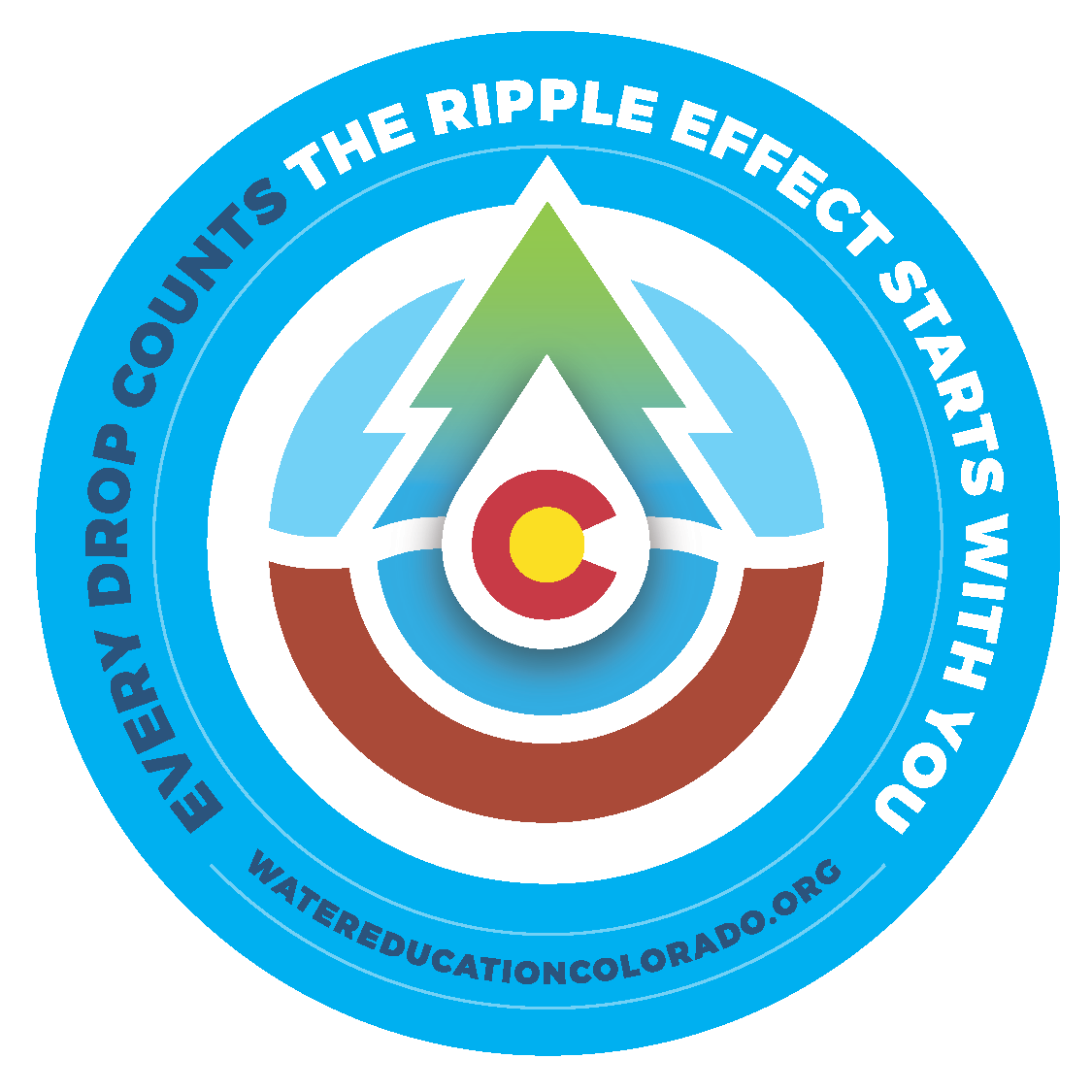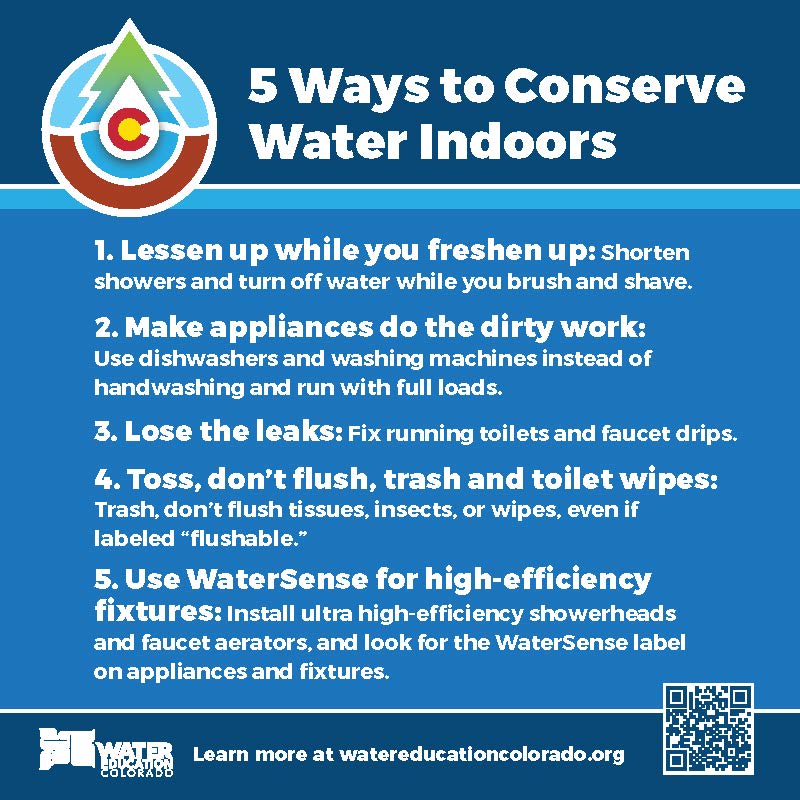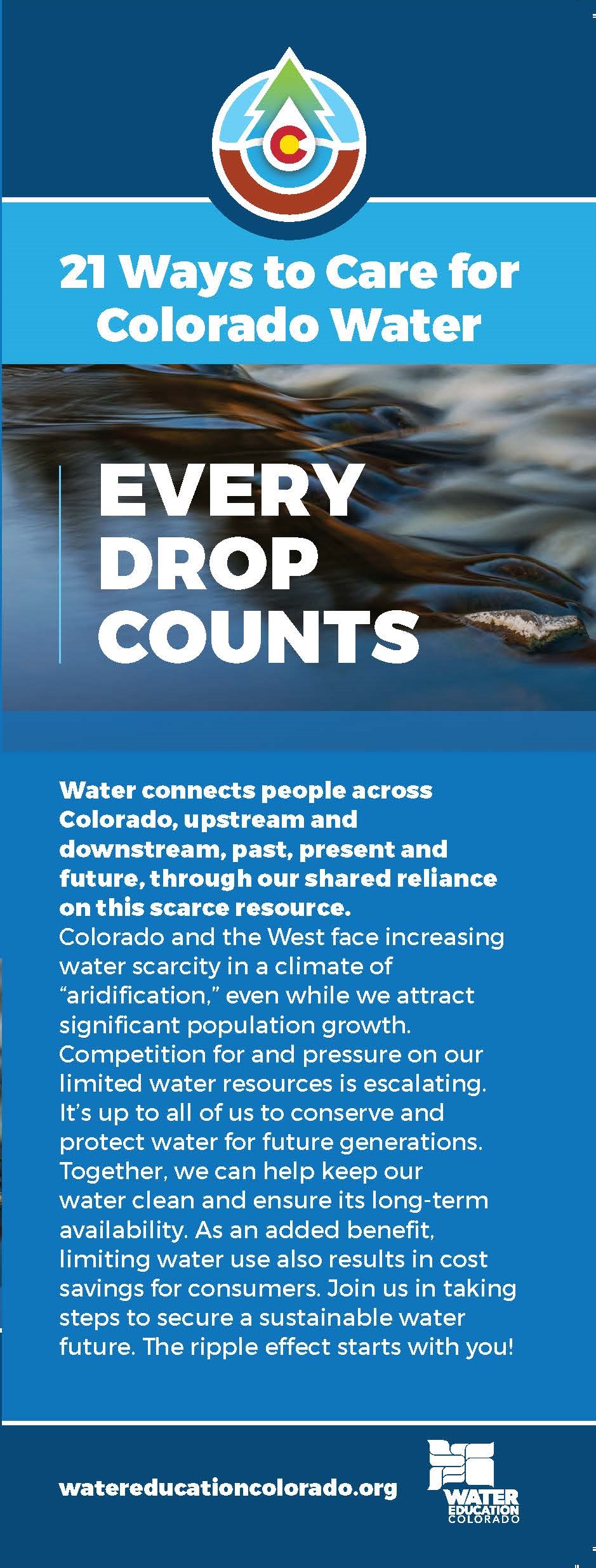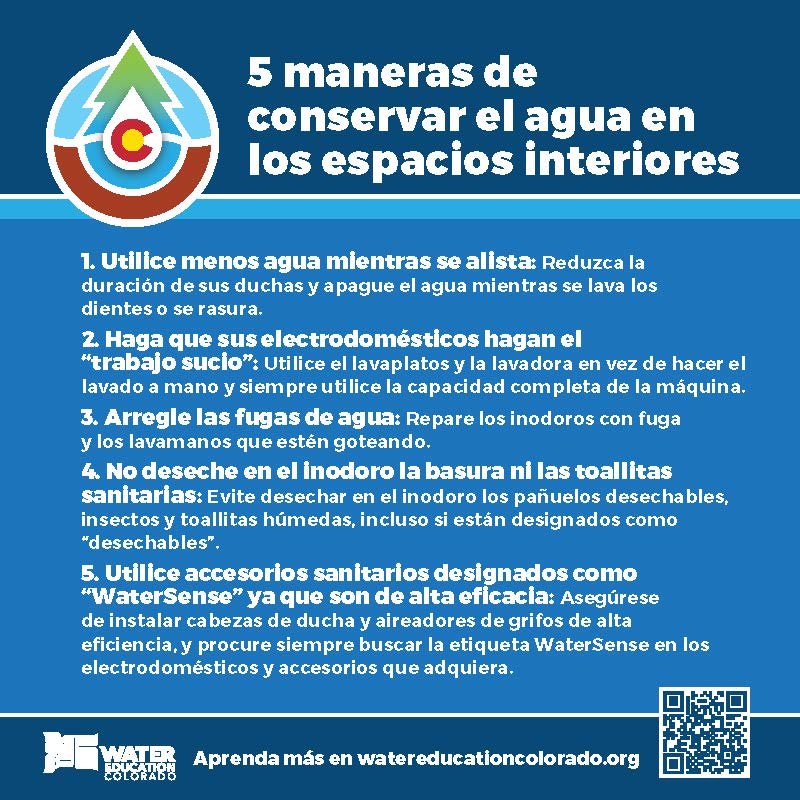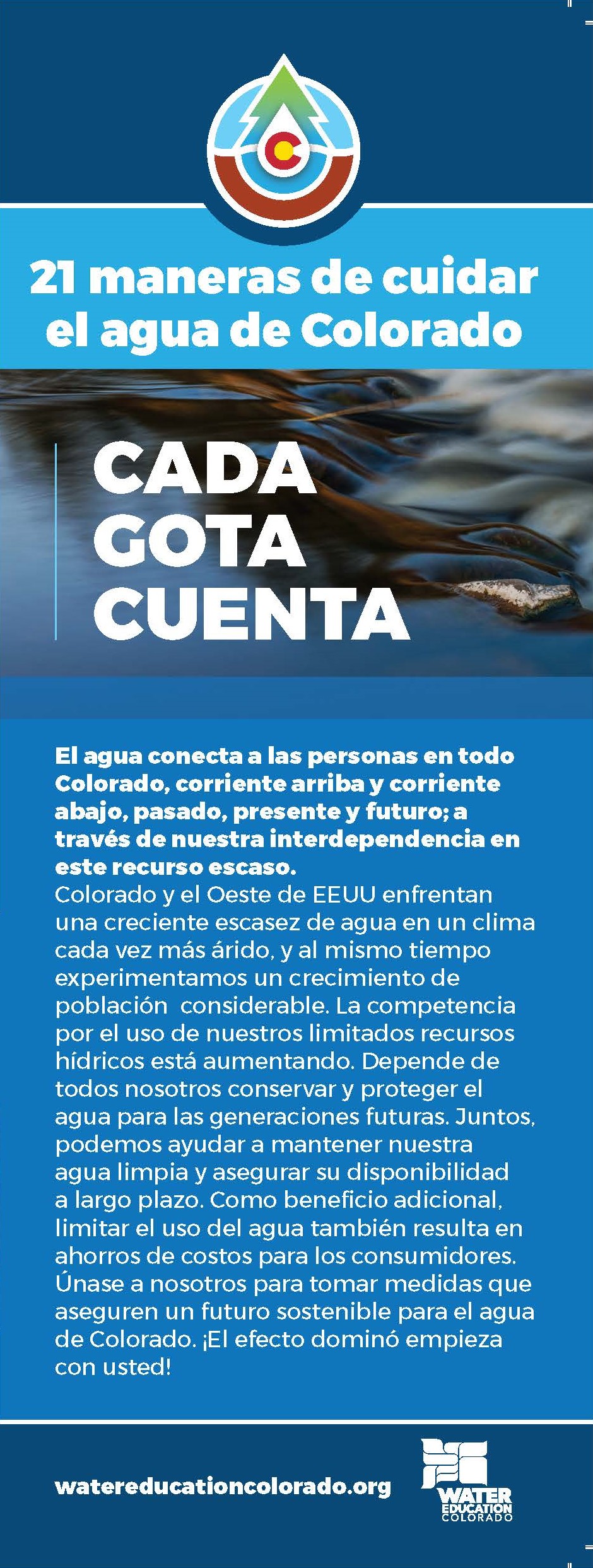21 Ways to Care for Colorado Water
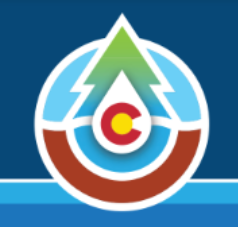 Every Drop Counts
Every Drop Counts
Water connects people across Colorado, upstream and downstream, past, present and future, through our shared reliance on this scarce resource. Colorado and the West face increasing water scarcity in a climate of “aridification,” even while we attract significant population growth. Competition for and pressure on our limited water resources is escalating. It’s up to all of us to conserve and protect water for future generations. Together, we can help keep our water clean and ensure its long-term availability. As an added benefit, limiting water use also results in cost savings for consumers. Join us in taking steps to secure a sustainable water future. The ripple effect starts with you!
*Thank you to Live Like You Love It® a program of Colorado WaterWise for providing many of the conservation tips below.
Know Your Water
1) Go to the source and know the destination:
What river or groundwater source are you drinking? And where does your water go after it’s used? Find out where your water comes from, where it goes, and trace its path through the watershed. Knowing where your water comes from and where it goes is the starting point to understanding how it’s all connected, and why your actions matter.
2) Explore your water footprint:
Learn about all of the ways you rely on water both directly and indirectly, through things like energy use, transportation, food, clothing, and other consumer products. Indirect water uses can amount to as much as 1,800 gallons of water per day. Learn more, calculate your water footprint, and consider ways to reduce it at https://www.watercalculator.org/.
Conserve Water Indoors
3) Lessen up while you freshen up:
Turn off the water while brushing your teeth or while shaving/soaping up in the shower. Go the extra step and take the 5-minute shower challenge! Every minute with the faucet off saves at least 2 gallons of water! Consider baths an occasional luxury: The typical bath uses 35-50 gallons of water, compared to 10 gallons for a 5-minute shower with a low-flow showerhead.
4) Make appliances do the dirty work:
Use the dishwasher and washing machine instead of handwashing, and run your appliances only when FULL. Depending on your machines, you can save anywhere from 15-30 gallons per load by filling up and cutting a load.
5) Lose the leaks:
Faucet and toilet leaks lead to lots of lost water, about 7 gallons per day for a faucet and 200 gallons for a toilet. Try these easy fixes: For a toilet leak, fix your flapper; for a faucet leak, replace the washer. Don’t know if you have a toilet leak? Try putting food coloring in the back tank. If color appears in the bowl, you have a leak.
6) Toss, don’t flush, trash and toilet wipes!:
Put waste like tissues, dead insects, and other items in the trash rather than flushing down the toilet. Make sure not to flush wipes, even if they say “flushable,” which can cause blocked sewer pipes. Every flush avoided saves about 1.5 gallons. What about expired or unused medicine? Don’t flush it! Check out the CDPHE’s Colorado Household Medication Take Back Program.
7) Use WaterSense for high-efficiency fixtures:
Install ultra-high-efficiency aerators on faucets and ultra-high-efficiency showerheads instead of conventional ones to save up to 2-2.5 gallons per minute. Look for WaterSense-labeled fixtures, including toilets. The average family can reduce water used for flushing toilets by 20-60%—that’s nearly 35 gallons per day! Since 2016, Colorado has only allowed fixtures that comply with federal WaterSense standards to be sold in state, but pay attention when ordering online because that’s not the case nationwide!
Conserve Water Outdoors
8) Go native and adaptive to limit turf in landscapes:
Reduce or omit thirsty bluegrass and replace with ColoradoScaped native, drought-tolerant plants and flowers. For any remaining turf, keep blades at least 3” tall to retain moisture. Check to see if your utility has any rebates or incentive programs to help with turf removal and replacement. Get ideas from plantselect.org.
9) Be sprinkler smart:
Install efficient sprinkler systems like drip irrigation, rotary nozzles and smart irrigation controllers, and program to water only at dawn and dusk and no more than three days per week. Then, maintain by repairing broken sprinkler heads and changing program settings seasonally as water demands diminish. Adjust sprinkler heads to avoid watering streets, sidewalks and driveways…they won’t grow!
10) When it rains, use it!
Skip watering if it recently rained or rain is in the forecast–a smart irrigation controller or rain sensor can help you do that. Direct downspouts to garden areas, not sidewalks or streets, and use rain barrels to capture rainfall for later use on plants and flowers. Since 2016, Coloradans have been allowed to have up to two 55-gallon rain barrels on their property for use in outdoor irrigation. Learn more at the Colorado Stormwater Center: http://stormwatercenter.colostate.edu/resources/rain-barrels/
11) Sweep, don’t spray:
Use a broom, not a hose, to clear debris from sidewalks and driveways.
12) Use your voice:
Talk to your property manager or HOA about smart outdoor watering practices. And anyone can encourage local officials and utilities to improve water conservation in their town or city. Keep it simple by sharing this tip sheet: https://extension.colostate.edu/topic-areas/yard-garden/lawn-care-7-202/
Protect Water Quality
13) Go commercial when shining up your wheels:
Wash your car at a commercial car wash instead of in the street or driveway. Car washes recycle and treat the water, which not only conserves, but also avoids soapy water going into storm drains.
14) Scoop the poop
Pick up after pets to reduce the transmission of E. coli and other diseases that pollute waterways.
15) Don’t P on your lawn:
Use only phosphorus-free fertilizer that is slow release and contains water-insoluble forms of nitrogen to prevent algae growth in rivers. Use pesticides sparingly, if at all.
16) Let only rain down storm drains:
Storm sewers drain directly to rivers with no treatment, so avoid dumping oil, pesticides, fertilizers, paints, etc. into them. Prevent and fix leaking automotive fluids, like oil, to keep them off roads and out of rivers; walking, biking, scootering, or driving electric vehicles can help avoid these fluids.
17) Got ice? Curb the salt:
The best way to remove snow and ice from your sidewalks and driveways is the old-fashioned way: Clear the snow and scrape the ice. For added traction, use sand sparingly instead of salt, then be sure to sweep it up after ice melts so it doesn’t wash into storm drains.
18) Install a rain garden:
Install a rain garden to grow beautiful plants fed by the rain, and to capture, filter and slow stormwater. Rain gardens also provide better replenishment for aquifers. Rain gardens are a simple and inexpensive way for homeowners and businesses to do their part in protecting our lakes, rivers and streams by managing stormwater. Learn more at the CSU Stormwater Center.
Respect Our Waterways
19) Recreate responsibly:
Be sure to apply Leave No Trace principles when enjoying the outdoors and use biodegradable products such as sunscreen, soaps, and cleaners when recreating in or around rivers and lakes.
20) Keep litter out of waterways:
Pick up litter when you see it and use reusable bags to keep blowing trash and plastic bags from reaching storm drains and waterways.
21) Stay informed and engaged:
Visit watereducationcolorado.org to learn more about Colorado water and sign up for updates. Get connected by volunteering for a local stream cleanup, attending a meeting of your river basin roundtable, or joining other planning and advocacy groups related to water in your community.
For use of the 21 Ways to Care for Colorado Water material and for co-branded files please reach out to the Programs Director, Sabrina Scherma – sabrina@wateredco.org.

